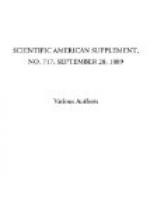At the close of the last century, Benjamin Thompson, born in Woburn, Mass., known to the world as Count Rumford, was in the workshop of the military arsenal of the King of Bavaria in Munich, superintending the boring of a cannon. The machinery was worked by two horses. He was surprised at the amount of heat which was generated, for when he threw the borings into a tumbler filled with cold water, it was set to boiling, greatly to the astonishment of the workmen. Whence came the heat? What was heat? The old philosopher said that it was an element. By experiment he discovered that a horse working two hours and twenty minutes with the boring machinery would heat nineteen pounds of water to the boiling point. He traced the heat to the horse, but with all his acumen he did not go on with the induction to the hay and oats, to the earth, the sunshine and rain, and so get back to the sun. One hundred years ago there was no chemical science worthy of the name, no knowledge of the constitution of plants or the properties of light and heat. The old philosophers considered light and heat to be fluids, which passed out of substances when they were too full. Count Rumford showed that motion was convertible into heat, but did not trace the motion to its source, so far as we know, in the sun.
It is only forty-six years since Professor Joule first demonstrated the mutual relations of all the manifestations of nature’s energy. Thirty-nine years only have passed since he announced the great law of the convertibility of force. He constructed a miniature churn which held one pound of water, and connected the revolving paddle of the churn with a wheel moved by a pound weight, wound up the weight, and set the paddle in motion. A thermometer detected the change of temperature and a graduated scale marked the distance traversed by the descending weight. Repeated experiments showed that a pound weight falling 772 feet would raise the temperature of water one degree, and that this was an unvarying law. This was transferring gravitation to heat, and the law held good when applied to electricity, magnetism, and chemical affinity, leading to the conclusion that they were severally manifestations of one universal power.—Congregationalist.
* * * * *
EARLY ELECTRIC LIGHTING.
The opening of the new station of the Electric Lighting Co., of Salem, Mass., was recently celebrated with appropriate festivities.
Among the letters of regret from those unable to attend the opening was the following from Prof. Moses G. Farmer:
“ELIOT, Me., Aug. 5, 1889.
“To the Salem Electric Lighting Company, Charles H. Price, President:
“GENTLEMEN: It would give me great pleasure to accept your kind invitation to be present at the opening of your new station in Salem on the 8th of this present August.




